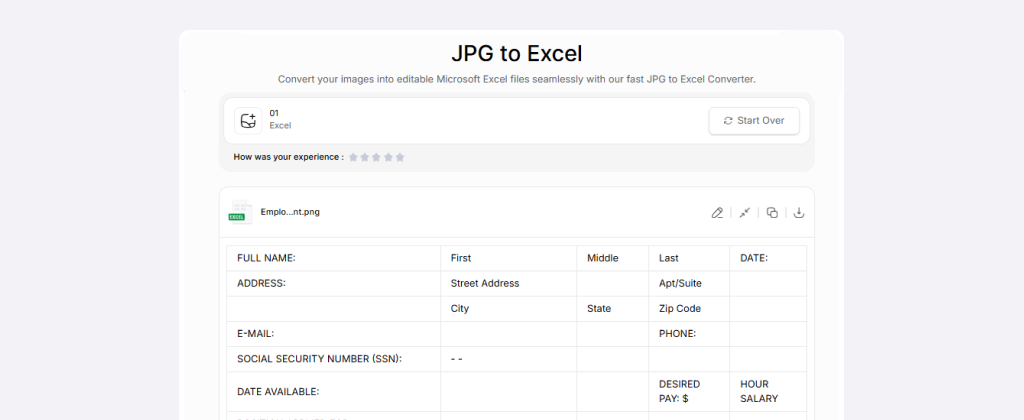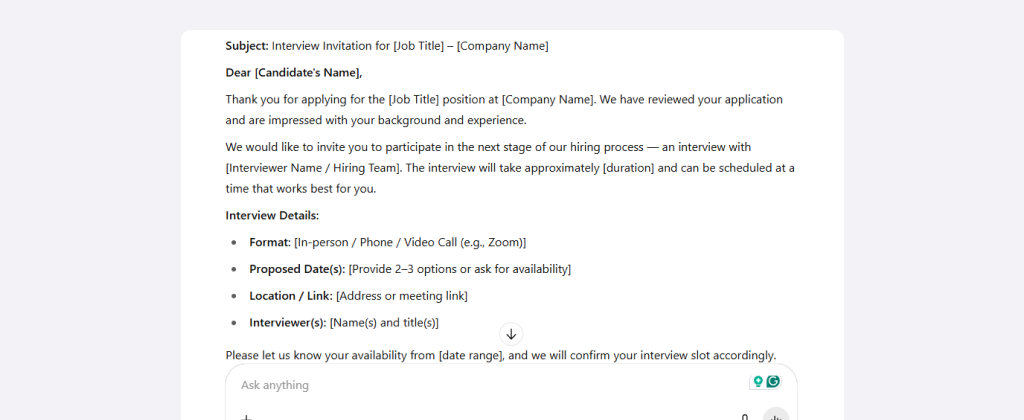The Role of Automation in Reducing HR Workload
From manufacturing to marketing, automation has reshaped every industry by streamlining tasks, boosting efficiency, and reducing workloads. The HR industry has been no exception. With the rise of tools powered by AI, AI workflow automation, Optical Character Recognition (OCR), and machine learning, HR professionals can offload routine tasks and reduce operational pressure. Beyond cutting down on manual effort, the right tools can help you:
- Reduce easily avoidable mistakes
- Improve HR productivity
- Maintain consistency in hiring processes
- Enhanced the overall candidate experience
This allows HR teams to focus more on strategic decisions and other areas that truly benefit from human input. In this blog, we’ll explore how automation is transforming HR processes and reducing the workload across departments.
How is Automation Reducing HR Workload in Different Areas?
In HR, automation refers to the use of technology-driven tools to streamline routine tasks and improve operational efficiency. Below, we explore key areas where automation is helping HR professionals cut down manual work and overall workload.
1. Minimize Manual Effort in Data Entry
One of the core responsibilities of HR professionals is data entry, and it’s a time-consuming task. From resumes and application forms to physical employee records, manually extracting and managing the data can be both tedious and error-prone.
Fortunately, OCR (Optical Character Recognition) powered tools have significantly improved the speed and accuracy of this task by automating data extraction from scanned or image-based documents, reducing the hassles and human mistakes. Using a free CRM can also help organize this extracted data efficiently, making it easier to manage employee information.
For instance, OCR-supported tools like Image to Excel Converter allow HR professionals to extract both text and tabular data from image files and directly into editable Excel sheets. This makes it easier to digitize large volumes of old employee records, application forms, and manage structured documents. As a result, you can save time, reduce errors, and improve data accessibility.

Example: We extracted data from an Employee form using the Image to Excel converter. The tool did its job in seconds and provided us with output in the form of well-structured Excel spreadsheets.
2. Accelerate Resume Screening
During the hiring process, recruiters often receive hundreds of resumes for a single job opening. Manually reviewing each resume and selecting candidates is a time-consuming, challenging, and overwhelming task. It’s not only inefficient, but also increases the risk of overlooking qualified candidates or making less-than-ideal hiring decisions.
Dedicated resume screening tools ease this part of the recruitment process. These tools can rapidly scan, review, filter, and rank resumes based on job descriptions and requirements after analyzing candidate skills, experiences, and qualifications. By identifying the most relevant profiles, automation helps HR teams pin down top talent quickly, saving time and improving hiring efficiency.

3. Smarter Virtual Interviews
Interviewing multiple candidates is another one of the most time-intensive tasks for HR professionals. From crafting personalized questions to scheduling interviews and evaluating responses, the traditional process is both repetitive and resource-heavy.
You can streamline this stage with AI-powered video interview platforms. These tools can generate customized interview questions based on job requirements, automate scheduling, and record candidate responses in the form of video, audio, or text for later review. This not only saves time but also enables more consistent and accurate evaluation of candidates, giving HR teams better insights to assess talent accurately and make informed hiring decisions.
4. Timely Communications
Engaging and updating candidates requires HR professionals to spend a significant amount of time crafting emails, responding to messages, and managing communication across channels, including social media.
In this scenario, Chatbot automation powered by AI‑driven chatbots like ChatGPT and similar tools is making the process more efficient. HR teams are also turning to AI sales engagement platforms to streamline communication further. They can quickly generate personalized emails, responses to queries, and even assist in drafting follow-ups, freeing up valuable time while keeping communication timely and consistent. For businesses that prefer data privacy and customization, the option to run ChatGPT locally can further enhance control while still benefiting from AI-driven efficiency.
For voice-based updates or confirmations, some HR teams also explore AI-powered phone calls to automate routine interactions. HR automation can improve communication accuracy by integrating processes like email validation to ensure candidate contact details are correct before sending updates. This helps reduce bounce rates, avoid miscommunication, and maintain professionalism during recruitment. To ensure the effectiveness of email verification, integrating an AI email verifier into your validation process can help detect invalid or risky addresses early and improve overall deliverability.
Example: We used ChatGPT to generate a customized email for communicating with a candidate during the recruitment process.

5. Onboarding Automation
Onboarding is another vital and time-consuming responsibility of HR teams. Managing the process, especially for multiple new hires, is hectic, overwhelming, and inefficient. Automation has transformed onboarding into a more streamlined and scalable process. HR teams looking for deeper personalization and feedback during onboarding often explore Userpilot alternatives to enhance employee engagement and automate user experiences beyond standard workflows. According to industry reports, automation can reduce onboarding time by up to 50%, significantly improving the new hire’s experience.
Platforms like BambooHR, Sapling, and others offer features that simplify various tasks, including onboarding, and reduce workloads. Here’s how:
- Document Management – New hires can fill out and submit key documents, such as ID proofs, tax forms, and agreements, digitally, eliminating the need for printing, scanning, or manual data entry. This also helps streamline contact management, keeping all employee information organized and easily accessible.
- Task Automation – Automated systems can verify documents, assign onboarding tasks, and schedule training sessions without constant HR intervention.
- Personalized Portals – New employees can access customized dashboards to explore company policies, team structures, training materials, and onboarding guides, minimizing the need for hands-on guidance. AI-powered tools, such as Plus AI, can help your team create branded induction presentations, guides, and other onboarding materials promptly, saving time that would otherwise be wasted on manual creation.
By automating these steps, HR professionals can focus more on creating a meaningful and engaging onboarding experience rather than getting bogged down in administrative tasks.
Pros and Cons of Automation in Human Resources
Pros
As discussed earlier, integrating automation into HR processes offers several key advantages. Here’s a quick overview:
- Time-Saving: Automation handles repetitive, time-consuming tasks, freeing HR teams to focus on strategic work.
- Error Reduction: It minimizes human errors commonly found in manual data handling.
- Consistency: Automated tools help maintain consistent performance and timely task completion.
- Improved Experience: Automation enhances both recruitment and onboarding journeys, making them more efficient and candidate-friendly.
- Data-Driven Decisions: With access to accurate and real-time data, HR professionals can make more informed hiring and management decisions. Integrating a contact management tool can further streamline communication with candidates and employees, keeping all information organized and easily accessible.
Cons
Despite the benefits, automation isn’t without challenges. Here are some potential drawbacks to keep in mind:
- High Initial Costs: Some automation tools can be costly to implement, especially for small businesses with limited budgets.
- Learning Curve: HR teams may need time and training to fully understand and use these tools effectively.
- Reduced Human Touch: Over-reliance on automation might result in less personalized communication and reduced employee engagement.
- Technical Issues: Glitches, downtime, or hardware failures can disrupt workflows and reduce overall efficiency.
While automation brings undeniable benefits to HR, from time saving to better decision-making, it’s most effective when used as a support system, not a replacement. Successfully implementing these technologies requires a robust ai strategy to ensure alignment with business goals and address potential challenges. The goal is to reduce administrative strain, so HR professionals can focus on building a meaningful employee experience and making people-centric decisions. When balanced well, automation and human insight can work hand-in-hand to elevate HR outcomes.
Conclusion
Automation has become a powerful ally for HR professionals, helping streamline repetitive tasks like data entry, recruitment, onboarding, and more. By reducing manual effort and minimizing errors, it not only boosts efficiency but also delivers more consistent and accurate outcomes.
It’s important to remember, automation isn’t about replacing people – it’s about empowering them.

Disclaimer: This article was authored by a guest contributor or third party. The views expressed are their own and do not necessarily reflect those of Jobma. Jobma does not endorse any products, services, or claims mentioned. This content is for informational purposes only.



